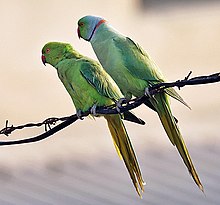Psittaculidae
| Psittaculidae | |
|---|---|

| |
| Rose-ringed parakeets (Psittacula krameri) | |
| Scientific classification | |
| Domain: | Eukaryota |
| Kingdom: | Animalia |
| Phylum: | Chordata |
| Class: | Aves |
| Order: | Psittaciformes |
| Superfamily: | Psittacoidea |
| Family: | Psittaculidae Vigors, 1825 |
| Subfamilies | |
Psittaculidae is a family of parrots, commonly known as Old World parrots, though this term is a misnomer, as not all its members occur in the Old World and Psittacinae also occurs in the Old World. It consists of six subfamilies: Psittrichasinae, Agapornithinae, Loriinae, Platycercinae, Psittacellinae and Psittaculinae.
Taxonomy
[edit]The following cladogram shows how the family Psittaculidae relates to the three other families in the order Psittaciformes. The tree is based on the work by Leo Joseph and collaborators published in 2012 but with the choice of families and the number of species in each family taken from the list maintained by Frank Gill, Pamela Rasmussen and David Donsker on behalf of the International Ornithological Committee (IOC), now the International Ornithologists' Union.[1][2] Joseph and collaborators proposed that the genera Psittrichas and Coracopsis should be placed in their own family, Psittrichasidae.[1] This proposal has not been adopted by taxonomists involved in curating lists of the world birds and instead these two genera are included in an expanded family Psittaculidae.[2][3][4][5]
| Psittaciformes |
| ||||||||||||||||||
The family Psittaculidae contains 203 species and is divided into 54 genera. Included are 13 species that have become extinct in historical times.[2] The following cladogram showing the generic relationships is based on a molecular phylogenetic study by Brian Smith and collaborators that was published in 2023. In the analysis two pairs of genera were found not to be monophyletic. These were Psittacula with Tanygnathus and Cyclopsitta with Psittaculirostris.[6] The number of species in each genus is taken from the IOC list.[2]
| Psittaculidae |
| ||||||||||||||||||||||||||||||||||||||||||||||||||||||||||||||||||||||||||||||||||||||||||||||||||||||||||||||||||||||||||||||||||||||||||||||||||||||||||||||||||||||||||||||||||||||||||||||||||||||||||||||||||||||||||||||||||||||||||||||||||||||||||||||||||||||||||||||||||||||||||
References
[edit]- ^ a b Joseph, L.; Toon, A.; Schirtzinger, E.E.; Wright, T.F.; Schodde, R. (2012). "A revised nomenclature and classification for family-group taxa of parrots (Psittaciformes)". Zootaxa. 3205 (1): 26–40. doi:10.11646/zootaxa.3205.1.2.
- ^ a b c d Gill, Frank; Donsker, David; Rasmussen, Pamela, eds. (July 2023). "Parrots, cockatoos". IOC World Bird List Version 13.2. International Ornithologists' Union. Retrieved 22 September 2023.
- ^ Dickinson, E.C.; Remsen, J.V. Jr., eds. (2013). The Howard & Moore Complete Checklist of the Birds of the World. Vol. 1: Non-passerines (4th ed.). Eastbourne, UK: Aves Press. pp. 369–370. ISBN 978-0-9568611-0-8.
- ^ Clements, J.F.; Schulenberg, T.S.; Iliff, M.J.; Fredericks, T.A.; Gerbracht, J.A.; Lepage, D.; Billerman, S.M.; Sullivan, B.L.; Wood, C.L. (2022). "The eBird/Clements Checklist of Birds of the World: v2022". Retrieved 18 June 2023.
- ^ "HBW and BirdLife Taxonomic Checklist v7". Birdlife International. Retrieved 18 June 2023.
- ^ Smith, B.T.; Merwin, J.; Provost, K.L.; Thom, G.; Brumfield, R.T.; Ferreira, M.; Mauck, W.M.I.; Moyle, R.G.; Wright, T.F.; Joseph, L. (2023). "Phylogenomic analysis of the parrots of the world distinguishes artifactual from biological sources of gene tree discordance". Systematic Biology. 72 (1): 228–241. doi:10.1093/sysbio/syac055. PMID 35916751.
